L8 Statistical Learning in Infants and Children
1/14
Earn XP
Description and Tags
Vocabulary flashcards about statistical learning, language and behaviour.
Name | Mastery | Learn | Test | Matching | Spaced |
|---|
No study sessions yet.
15 Terms
Statistical Learning
Learning of patterns in language and behavior using general learning mechanisms. Innate, assists grammar aquisition and word segmentation (key components of language aquisition)
Innate or early learning abilities
At birth, infants have been learning about language in the womb. They can discriminate most sound contrasts used in todays languages. By one year, they only make contrasts present in their own language, their many abilities are lost depending on exposure.
Nativism (Chomsky)
The belief that certain abilities, like grammar, are innate.
Universal Grammar
The theory that all languages share certain innate principles of grammar, (disproved cause research couldn’t back it up).
Statistical Learning and Grammar
Grammatical categories occur in predictable positions in sentences, leading to frequent frames that aid language learning. The brain is specialised for statistical learning.

Statistical Learning and Word Segmentation
Infants use transitional probabilities between syllable pairs to identify word boundaries in continuous speech. (pi is likely to be followed by roz) Stimulus isnt impoverished.

Statistical learning in sleeping newborns
While asleep, listened to a string of nonsense syllables containing old and new words. Brain activity was measured and showed different response to old words and new. Showing even when asleep they use familiarity to group sounds into words.
Specific Language Impairment (SLI)
A language disorder characterized by short sentences, small vocabularies, and difficulty learning new words. General difficulty with statistical learning.

SLI and statistical learning
Statistical learning is central to language learning, therefore better stat learning= better language ability. Children are good at learning patterns in tones and syllables. SLI kids find that hard.
Statistical learning and social knowledge
Some think infants have innate theory of mind. Some say infants learn to predict patterns in behaviour
Behaviour is predictable
Infants look longer at mid-action of sequence than completed sequence. Showing they don’t need innate social understanding but learn to predict patterns of behaviour, and later work out mental states behind the behaviour (eg. drink coffee because its nice)

Correlation in Repeated Behaviors and Vocabulary
Repeated behaviors convey mental states such as desires, therefore correlate with mental state vocabulary
Why repeated behaviours correlate with mental state words (eg. likes/wants)
Childs survival depends on learning about events so they can predict outcomes and understand peoples motives. The more they see behaviours of liking or wanting, the more they hear mental state words to describe these behaviours.
what is innate
Chompsky says aspects of language, some say theory of mind. But its more likely that the ability to learn patterns (in language, behaviour, etc) is innate
Innate Theory of Mind
The understanding that people have goals, desires, and beliefs (internal experiences).